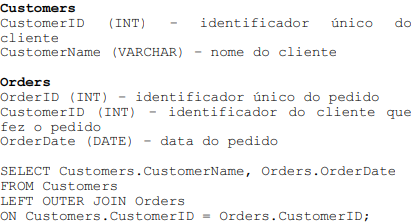Questões de Concurso Público TCE-AC 2024 para Analista de Tecnologia da Informação - Área: Gestão de Dados
Foram encontradas 120 questões
À luz da Lei Orgânica do Tribunal de Contas do Estado do Acre (TCEAC), julgue o item que se segue.
O diário eletrônico de contas pode ser utilizado como meio
oficial de publicação e divulgação dos atos administrativos e
das comunicações do estado do Acre e de seus municípios.
À luz da Lei Orgânica do Tribunal de Contas do Estado do Acre (TCEAC), julgue o item que se segue.
A Secretaria Geral não é órgão de administração superior do
TCEAC, embora seja de sua competência atuar junto ao
presidente do tribunal na fixação dos objetivos e na
orientação das atividades da corte de contas.
Considerando o Regimento Interno do TCEAC, julgue o item seguinte.
Terá a forma de instrução normativa a deliberação do
TCEAC que consista em ato normativo de natureza não
regimental e que contenha matéria e determinação que
envolva pessoa física, órgão ou entidade sujeita à jurisdição
desse tribunal.
Considerando o Regimento Interno do TCEAC, julgue o item seguinte.
A intimação do Ministério Público Especial, em qualquer
caso, é feita pessoalmente ao seu procurador-chefe ou a
quem o estiver substituindo.
Com base na Lei Complementar estadual n.º 39/1993 (Estatuto dos Servidores Públicos Civis do Estado do Acre), julgue o próximo item.
Em regra, veda-se o desconto sobre a remuneração ou o
provento do servidor público, no entanto, como exceção a
essa regra, permite-se exclusivamente o desconto ou por
ordem judicial ou por autorização do próprio servidor, para
fins de consignação em folha de pagamento.
Em relação às funções da administração, a estrutura e comportamento organizacional e a competência interpessoal e gerenciamento de conflitos, julgue o próximo item.
Um gerente eficaz é capaz de estimular o conflito construtivo em situações nas quais a satisfação com o status quo iniba a
mudança e o desenvolvimento necessários.
Em relação às funções da administração, a estrutura e comportamento organizacional e a competência interpessoal e gerenciamento de conflitos, julgue o próximo item.
Quanto maior a formalização, maior é a eficiência organizacional e menor é a presença de normas de conduta, rotinas e
procedimentos, formulários e documentos para comprovar as atividades.
Em relação às funções da administração, a estrutura e comportamento organizacional e a competência interpessoal e gerenciamento de conflitos, julgue o próximo item.
O poder da comunicação interpessoal está na obtenção de pontos de vista diferenciados, terreno fértil para soluções criativas.
Em relação às funções da administração, a estrutura e comportamento organizacional e a competência interpessoal e gerenciamento de conflitos, julgue o próximo item.
À medida que uma estratégia é formulada, ela deve assentar-se em uma estrutura organizacional adequada e receber apoio de uma
cultura organizacional.
Em relação às funções da administração, a estrutura e comportamento organizacional e a competência interpessoal e gerenciamento de conflitos, julgue o próximo item.
A avaliação de desempenho é um processo de avaliação contínua que obriga os funcionários a superarem sistematicamente seus
níveis de desempenho.
Em relação a banco de dados, julgue o item a seguir.
Os índices em um banco de dados melhoram o desempenho
das operações de leitura, mas podem aumentar os custos de
armazenamento e impactar negativamente as operações de
escrita.
Em relação a banco de dados, julgue o item a seguir.
Na atomicidade, uma transação deve ser tratada como uma
unidade única e indivisível, garantindo que todas as
operações dentro dela sejam concluídas com sucesso,
independentemente de uma falha no sistema.
Em relação a banco de dados, julgue o item a seguir.
Em um banco de dados federado, cada banco de dados
mantém sua estrutura e gerenciamento próprios, enquanto a
federação permite que os bancos sejam acessados e
consultados de maneira centralizada.
Em relação a banco de dados, julgue o item a seguir.
A primeira forma normal (1FN) em bancos de dados permite
que uma tabela contenha atributos multivalorados, desde que
esses valores sejam de tipos de dados distintos.
Em relação a banco de dados, julgue o item a seguir.
Os bancos de dados não relacionais se diferenciam dos
bancos de dados relacionais por utilizarem de forma
exclusiva objetos codificados com estado armazenado em
um atributo estruturado, em vez de tabelas com colunas e
linhas.
A seguir, são apresentadas as estruturas de duas tabelas, de nomes Customers e Orders, em um banco de dados, e também um comando SQL relativo a essas tabelas.

Com base nessas informações, julgue o item subsequente.
A cláusula ON na consulta estabelece a condição para a
junção das duas tabelas, especificando que o CustomerID
da tabela Customers deve corresponder ao OrderID da
tabela Orders.
A seguir, são apresentadas as estruturas de duas tabelas, de nomes Customers e Orders, em um banco de dados, e também um comando SQL relativo a essas tabelas.

Com base nessas informações, julgue o item subsequente.
A consulta retorna uma lista com o nome de todos os clientes
e a data do pedido que eles fizeram, e mostra NULL na coluna
data do pedido para os clientes que não possuem pedido.
Acerca dos níveis de isolamento do Oracle 21C, julgue o item que se segue.
O nível de isolamento REPEATABLE READ é suscetível ao
problema de “fantasmas”, que ocorre quando novas linhas
inseridas por outras transações podem não ser visíveis para a
transação atual.
Acerca dos níveis de isolamento do Oracle 21C, julgue o item que se segue.
No nível de isolamento SERIALIZABLE, uma transação em
andamento pode visualizar as alterações realizadas por outras
transações, independentemente delas terem sido confirmadas
ou não.
No que se refere ao banco de dados ADABAS, julgue o item abaixo.
O ADABAS permite a comunicação com outros sistemas
gerenciadores de banco de dados por meio do driver ODBC,
desde que essa comunicação seja exclusivamente de
consultas para uma única partição.